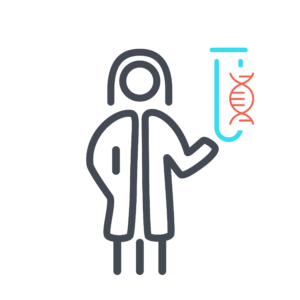TCF20-Related Syndrome

Table of contents
- What is TCF20-related syndrome?
- Key Role
- Symptoms
- What causes TCF20-related syndrome?
- Why does my child have a change in the TCF20 gene?
- What are the chances that other family members of future children will have TCF20-related syndrome?
- How many people have TCF20-related syndrome?
- Do people who have TCF20-related syndrome look different?
- How is TCF20-related syndrome treated?
- Behavior and development concerns linked to TCF20-related syndrome
- Medical and physical concerns linked to TCF20-related syndrome
- Where can I find support and resources?
- Sources and References
What is TCF20-related syndrome?
TCF20-related syndrome happens when there are changes in the TCF20 gene. These changes can keep the gene from working as it should.

Key Role
The TCF20 gene plays a key role in the development of brain cells. It also controls other genes that help guide brain development.
Symptoms
Because the TCF20 gene is important for brain activity, many people who have TCF20-related syndrome have:
- Developmental delay
- Intellectual disability
- Autism spectrum disorder or features of autism
- Low muscle tone, also called hypotonia
- High muscle tone, also called hypertonia
- Seizures
- Language issues
- Vision or eye issues
- Heart issues
- Behavioral issues, including attention-deficit/hyperactivity disorder (ADHD), anxiety, depression, aggression, sensory issues, obsessive compulsive disorder
- Genitourinary defects
- Gastrointestinal issues
- Skeletal issues
- Skin issues
- Overgrowth issues, including a larger than average head size, also called macrocephaly
- Sleep issues
- Movement issues
- Brain changes seen on magnetic resonance imaging (MRI)
What causes TCF20-related syndrome?
TCF20-related syndrome is a genetic condition, which means that it is caused by variants in genes. Our genes contain the instructions, or code, that tell our cells how to grow, develop, and work. Every child gets two copies of the TCF20 gene: one copy from their mother’s egg, and one copy from their father’s sperm. In most cases, parents pass on exact copies of the gene to their child. But the process of creating the egg or sperm is not perfect. A change in the genetic code can lead to physical issues, developmental issues, or both.
Sometimes a spontaneous variant happens in the sperm, egg or after fertilization. When a brand new genetic variant happens in the genetic code is called a ‘de novo’ genetic variant. The child is usually the first in the family to have the genetic variant.
De novo variants can take place in any gene. We all have some de novo variants, most of which don’t affect our health. But because TCF20 plays a key role in development, de novo variants in this gene can have a meaningful effect.
Research shows that TCF20-related syndrome is often the result of a de novo variant in TCF20. Many parents who have had their genes tested do not have the TCF20 genetic variant found in their child who has the syndrome. In some cases, TCF20-related syndrome happens because the genetic variant was passed down from a parent.
Autosomal dominant conditions
TCF20-related syndrome is an autosomal dominant genetic condition. This means that when a person has the one damaging variant in TCF20 they will likely have symptoms of TCF20-related syndrome. For someone with an autosomal dominant genetic syndrome, every time they have a child there is a 50 percent chance they pass on the same genetic variant and a 50 percent chance they do not pass on the same genetic variant.
Autosomal Dominant Genetic Syndrome
Why does my child have a change in the TCF20 gene?
No parent causes their child’s TCF20-related syndrome. We know this because no parent has any control over the gene changes that they do or do not pass on to their children. Please keep in mind that nothing a parent does before or during the pregnancy causes this to happen. The gene change takes place on its own and cannot be foreseen or stopped.
What are the chances that other family members of future children will have TCF20-related syndrome?
Each family is different. A geneticist or genetic counselor can give you advice on the chance that this will happen again in your family.
The risk of having another child who has TCF20-related syndrome depends on the genes of both biological parents.
- If neither biological parent has the same genetic variant found in their child, the chance of having another child who has the syndrome is on average 1 percent. This 1 percent chance is higher than the chance of the general population. The increase in risk is due to the very unlikely chance that more of the mother’s egg cells or the father’s sperm cells carry the same genetic variant.
- If one biological parent has the same genetic variant found in their child, the chance of having another child who has the syndrome is 50 percent.
For a symptom-free brother or sister of someone who has TCF20-related syndrome, the sibling’s risk of having a child who has TCF20-related syndrome depends on the sibling’s genes and their parents’ genes.
- If neither parent has the same genetic variant causing TCF20-related syndrome, the symptom-free sibling has a nearly 0 percent chance of having a child who would inherit TCF20-related syndrome.
- If one biological parent has the same genetic variant causing TCF20-related syndrome, the symptom-free sibling has a 50 percent chance of also having the same genetic variant. If the symptom-free sibling has the same genetic variant, their chance of having a child who has the genetic variant is 50 percent.
For a person who has TCF20-related syndrome, the risk of having a child who has the syndrome is about 50 percent.

How many people have TCF20-related syndrome?
As of 2025, over 110 people with TCF20-related syndrome have been identified in a medical clinic.

Do people who have TCF20-related syndrome look different?
People who have TCF20-related syndrome may look different. Appearance can vary and can include some but not all of these features:
- Noticeable forehead
- Tented upper lip
- Full cheeks
- Triangular face
- Depressed nasal bridge
- Short nose
- Wide eyebrows
- Low-set ears
- Skin folds at the eyes, also called epicanthal folds

How is TCF20-related syndrome treated?
Scientists and doctors have only just begun to study TCF20-related syndrome. At this point, there are no medicines designed to treat the syndrome. A genetic diagnosis can help people decide on the best way to track the condition and manage therapies. Doctors can refer people to specialists for:
- Physical exams and brain studies
- Genetics consults
- Development and behavior studies
- Other issues, as needed
A developmental pediatrician, neurologist, or psychologist can follow progress over time and can help:
- Suggest the right therapies. This can include physical, occupational, speech, or behavioral therapy.
- Guide individualized education plans (IEPs).
Specialists advise that therapies for TCF20-related syndrome should begin as early as possible, ideally before a child begins school.
If seizures happen, consult a neurologist. There are many types of seizures, and not all types are easy to spot. To learn more, you can refer to resources such as the Epilepsy Foundation’s website: epilepsy.com/learn/types-seizures.

This section includes a summary of information from major published articles. It highlights how many people have different symptoms. To learn more about the articles, see the Sources and References section of this guide.
Behavior and development concerns linked to TCF20-related syndrome
Learning
Most people with TCF20-related syndrome had global developmental delay and/or intellectual disabilities, from mild to profound.
- 76 out of 86 people had global developmental delay and/or intellectual disability (88 percent)
- 29 out of 33 people had language delay (88 percent)
Behavior
People with TCF20-related syndrome had behavioral issues, such as autism, attention-deficit/hyperactivity disorder (ADHD), depression, or anxiety.
- 43 out of 77 people had autism or features of autism (56 percent)
- 31 out of 71 people had ADHD (44 percent)
- 36 out of 71 people had other neurobehavioral diagnoses or concerns (51 percent)

Brain
People with TCF20-related syndrome had low muscle tone (hypotonia), seizures, and/or had changes seen on magnetic resonance imaging (MRI).
- 42 out of 70 people had hypotonia (60 percent)
- 14 out of 71 people had seizures (20 percent)
- 15 out of 58 people had changes seen on MRI (26 percent)

Medical and physical concerns linked to TCF20-related syndrome
Growth
Some people with TCF20-related syndrome had overgrowth issues, including but not limited to a larger than average head size (macrocephaly).
- 14 out of 62 people had overgrowth issues (23 percent)
- 14 out of 74 people had macrocephaly (19 percent)
Vision and hearing
Some people with TCF20-related syndrome had vision issues like crossed eyes (strabismus), nearsightedness (myopia), and issues with the cornea (keratoconus).
- 21 out of 45 people had vision issues (47 percent)
Gastrointestinal
People with TCF20-related syndrome had gastrointestinal issues, mainly constipation.
- 17 out of 33 people had gastrointestinal issues (52 percent)
Heart
Some people with TCF20-related syndrome had heart issues, mainly mitral valve prolapse and bundle branch block.
- 5 out of 33 people had heart issues (15 percent)
Musculoskeletal
Some people with TCF20-related syndrome had musculoskeletal issues, mainly sideways curve of the spine (scoliosis).
- 18 out of 40 people had musculoskeletal issues (45 percent)

Where can I find support and resources?
Simons Searchlight
Simons Searchlight is an online international research program, building an ever growing natural history database, biorepository, and resource network of over 175 rare genetic neurodevelopmental disorders. By joining their community and sharing your experiences, you contribute to a growing database used by scientists worldwide to advance the understanding of your genetic condition. Through online surveys and optional blood sample collection, they gather valuable information to improve lives and drive scientific progress. Families like yours are the key to making meaningful progress. To register for Simons Searchlight, go to the Simons Searchlight website at www.simonssearchlight.org and click “Join Us.”
- Learn more about Simons Searchlight: www.simonssearchlight.org/frequently-asked-questions
- Simons Searchlight webpage with more information on TCF20: www.simonssearchlight.org/research/what-we-study/tcf20
- Simons Searchlight Facebook group: https://www.facebook.com/groups/tcf20

Sources and References
The content in this guide comes from published studies about TCF20-related syndrome.
- Huang, S., Xu, J., Li, Y., Mo, W., Lin, X., Wang, Y., Liang, F., Bai, Y., Huang, G., … & Ma, G. (2023). A syndrome featuring developmental disorder of the nervous system induced by a novel mutation in the TCF20 gene, rarely concurrent immune disorders: A case report. Frontiers in Genetics, 14, 1192668. https://pmc.ncbi.nlm.nih.gov/articles/PMC10248432/
- Schneeweiss, M. R., Dale, B., & Ejaz, R. (2022). Diagnosis and clinical presentation of two individuals with a rare TCF20 pathogenic variant. BMJ Case Reports, 15(12), e248995. https://pmc.ncbi.nlm.nih.gov/articles/PMC9730367/
- Vetrini, F., McKee, S., Rosenfeld, J. A., Suri, M., Lewis, A. M., Nugent, K. M., Roeder, E., Littlejohn, R. O., Holder, S., … & Liu, P. (2019). De novo and inherited TCF20 pathogenic variants are associated with intellectual disability, dysmorphic features, hypotonia, and neurological impairments with similarities to Smith-Magenis syndrome. Genome Medicine, 11(1), 12. https://pubmed.ncbi.nlm.nih.gov/30909959/
